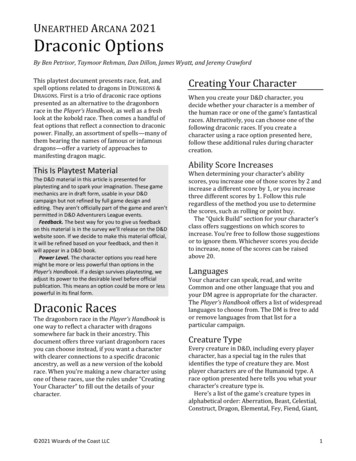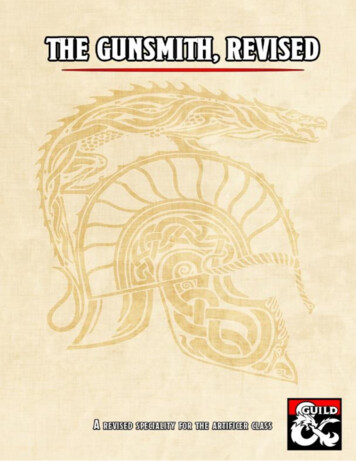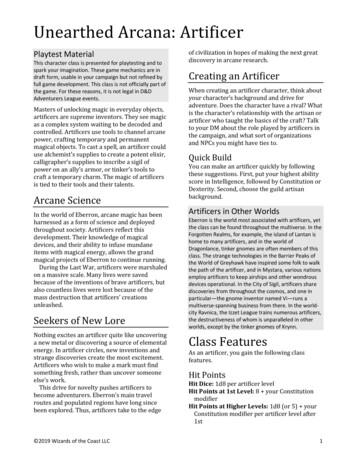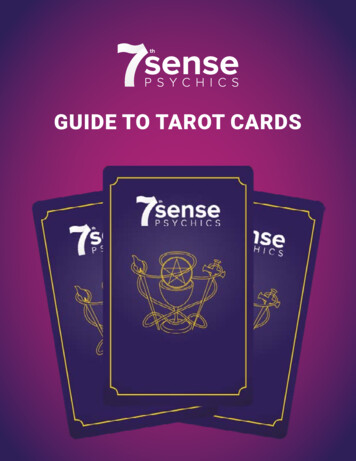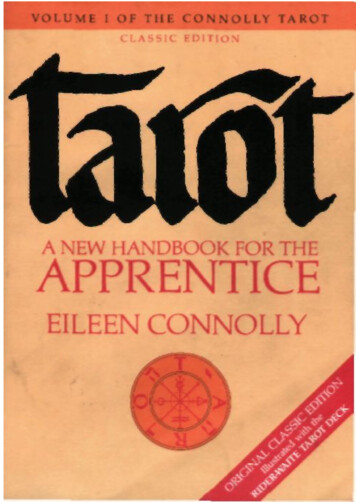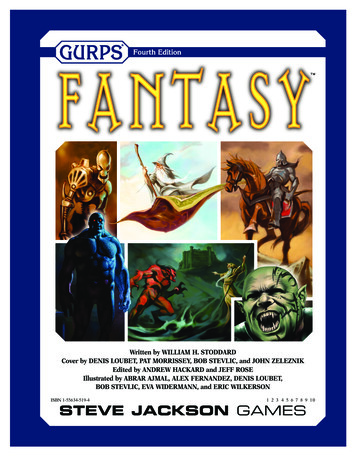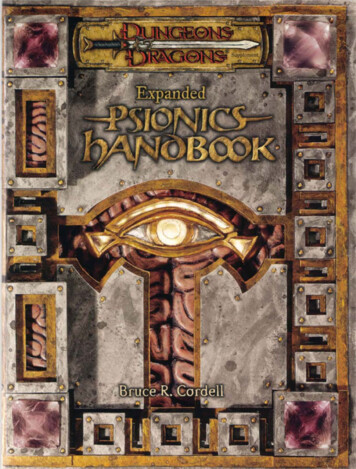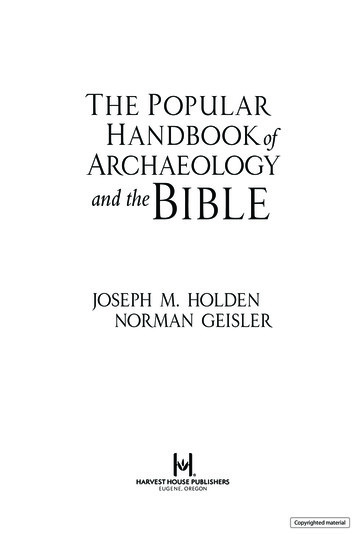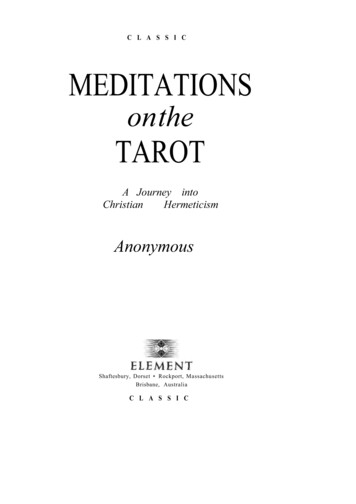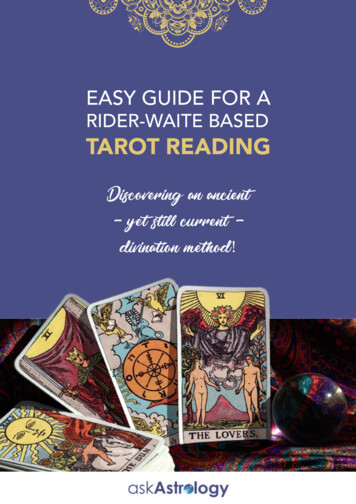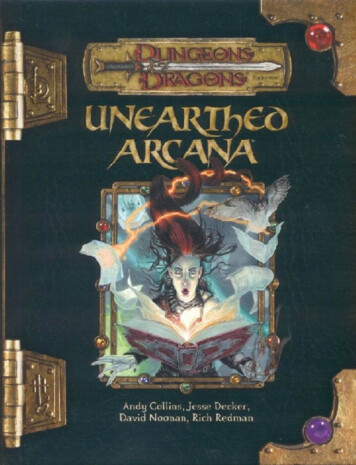
Transcription
UNEARTHED ARCANAANDY COLLINS, JESSE DECKER, DAVID NOONAN, RICH REDMANA D D I T I O N A LD E S I G NANDREW FINCH, STEVE KENSON, CHARLESRYAN, BILL SLAVICSEK, ED STARK, JONATHANTWEET, JD WIKER, JAMES WYATTEDITORSMICHELE CARTER, GWENDOLYN F.M.KESTREL, CHARLES RYANM A N A G I N GE D I T O RKIM MOHAND E S I G NM A N A G E RED STARKD I R E C T O RO FR P GR & DBILL SLAVICSEKI M A G ERTDIRECTORISTDAWN MURINCOVERARTMATT CAVOTTAI N T E R I O RA R T I S T SSTEVEN BELLEDIN, ED COX, WAYNE ENGLAND,EMILY FIEGENSCHUH, DAVID HUDNUT,JEREMY JARVIS, DOUG KOVACS, JOHN ANDLAURA LAKEY, DAVID MARTIN, DENNISCRABAPPLE MCCLAIN, MARK NELSON, JAMESPAVELEC, STEVE PRESCOTT, DAVID ROACH,RICHARD SARDINHA, RON SPENCER, STEPHENTAPPIN, JOEL THOMAS, BEN THOMPSONG R A P H I CD E S I G N E RDAWN MURINT E C H N I C I A NJAY SAKAMOTOP R O D U C T I O NAGRAPHIC PRODUCTION SPECIALISTERIN DORRIESM A N A G E RCARTJOSH FISCHEROGRAPHERTODD GAMBLEThis d20 System game utilizes mechanics developed for the new DUNGEONS & DRAGONS game by Jonathan Tweet, Monte Cook,Skip Williams, Richard Baker, and Peter Adkison.Resources for this product include Psionics Handbook by Bruce Cordell, Swords of Our Fathers by JD Wiker (Game Mechanics),Mutants & Masterminds by Steve Kenson (Green Ronin Publishing), Call of Cthulhu by Monte Cook and John Tynes, d20 Modern Roleplaying Game by Bill Slavicsek, Jeff Grubb, Rich Redman, and Charles Ryan, Oriental Adventures by James Wyatt, StarWars Roleplaying Game by Bill Slavicsek, Andy Collins, and JD Wiker, Player’s Option: Combat & Tactics by L. Richard Baker IIIand Skip Williams, Alternity Player’s Handbook by Bill Slavicsek and Richard Baker, and the University of Notre Dame’s Latinparser at http://www.nd.edu/ archives/latgramm.htm.Valuable advice provided by Bruce Cordell and James WyattPlaytesters: Richard Baker, Greg Collins, Dale Donovan, Chris Galvin, Joe Hauck, Kevin Kukas, Viet Nguyen, Brent Pearson, TimRhoades, Marc Russell, Scott Smith, Dennis Worrell, Warren Wyman, James WyattU.S., CANADA, ASIA, PACIFIC,EUROPEAN HEADQUARTERS& LATIN AMERICAWizards of the Coast, BelgiumWizards of the Coast, Inc.T Hofveld 6dP.O. Box 7071702 Groot-BijgaardenRenton WA 98057-0707Belgium620-88156-001-ENQuestions? 1-800-324-6496 322-467-33609 8 7 6 5 4 3 2 1FIRST PRINTING: February 2004Product Identity: The following items are hereby identified as Product Identity, as defined in the Open Gaming License version 1.0a, Section 1(e), and are not Open Content: Alltrademarks, registered trademarks, proper names (characters, deities, artifacts, places, etc.), artwork, trade dress, and the names and game statistics for the following monsters:beholder, displacer beast, gauth, githyanki, githzerai, mind flayer, slaad, umber hulk, and yuan-ti.Open Content: Except for material designated as Product Identity (see above) and the githyanki/githzerai, slaad, and yuan-ti bloodlines in Chapter 1, the contents of this WIZARDSOF THE COAST game product are Open Game Content, as defined in the Open Gaming License version 1.0a Section 1(d). No portion of this work other than the material designatedas Open Game Content may be reproduced in any form without written permission. To learn more about the Open Gaming License and the d20 System License, please visitwww.wizards.com/d20.DUNGEONS & DRAGONS, D&D, DUNGEON MASTER, d20, d20 MODERN, d20 System, WIZARDS OF THE COAST, Player’s Handbook, Dungeon Master’s Guide, Monster Manual, UnearthedArcana, and their respective logos are trademarks of Wizards of the Coast, Inc., in the U.S.A. and other countries. Distributed to the hobby, toy, and comic trade in the UnitedStates and Canada by regional distributors. Distributed in the United States to the book trade by Holtzbrinck Publishing. Distributed in Canada to the book trade by FennLtd. Distributed worldwide by Wizards of the Coast, Inc., and regional distributors. This material is protected under the copyright laws of the United States of America. Anyreproduction or unauthorized use of the material or artwork contained herein is prohibited without the express written permission of Wizards of the Coast, Inc. This product is awork of fiction. Any similarity to actual people, organizations, places, or events is purely coincidental. Printed in the U.S.A. 2004 Wizards of the Coast, Inc.Visit our website at www.wizards.com/dnd620 88156 UnearthedArcana2.indd 212/10/03, 2:27:49 PM
ContentsIntroduction .4Chapter 1: Races.5Environmental Racial Variants . . . . . . . . . . . . 5Elemental Racial Variants . . . . . . . . . . . . . . . . 15Reducing Level Adjustments . . . . . . . . . . . . . 18Bloodlines . . . . . . . . . . . . . . . . . . . . . . . . . . . . . . . 19Racial Paragon Classes . . . . . . . . . . . . . . . . . . . 32Chapter 2: Classes .4747596465697276Chapter 3: Building Characters .79Alternative Skill Systems . . . . . . . . . . . . . . . . . 79Complex Skill Checks. . . . . . . . . . . . . . . . . . . . 81Character Traits . . . . . . . . . . . . . . . . . . . . . . . . . . 86Character Flaws . . . . . . . . . . . . . . . . . . . . . . . . . . 91Spelltouched Feats . . . . . . . . . . . . . . . . . . . . . . . 92Weapon Group Feats . . . . . . . . . . . . . . . . . . . . . 94Craft Points . . . . . . . . . . . . . . . . . . . . . . . . . . . . . . 97Character Background . . . . . . . . . . . . . . . . . . 100Chapter 4: Adventuring. 109Defense Bonus . . . . . . . . . . . . . . . . . . . . . . . . . .Armor as Damage Reduction . . . . . . . . . . . .Damage Conversion . . . . . . . . . . . . . . . . . . . . .Injury . . . . . . . . . . . . . . . . . . . . . . . . . . . . . . . . . .Vitality and Wound Points . . . . . . . . . . . . . .Reserve Points . . . . . . . . . . . . . . . . . . . . . . . . . .Massive Damage Thresholdsand Results . . . . . . . . . . . . . . . . . . . . . . . . . .Death and Dying. . . . . . . . . . . . . . . . . . . . . . . .Action Points . . . . . . . . . . . . . . . . . . . . . . . . . . .Combat Facing . . . . . . . . . . . . . . . . . . . . . . . . . .Hex Grid . . . . . . . . . . . . . . . . . . . . . . . . . . . . . . .Variable Modifiers . . . . . . . . . . . . . . . . . . . . . .Bell Curve Rolls . . . . . . . . . . . . . . . . . . . . . . . .Players Roll All the Dice. . . . . . . . . . . . . . . . .109111112113115119119121122124128129132133Chapter 5: Magic.135Magic Rating . . . . . . . . . . . . . . . . . . . . . . . . . . .Summon Monster Variants. . . . . . . . . . . . . . . .Metamagic Components . . . . . . . . . . . . . . . .Spontaneous Metamagic . . . . . . . . . . . . . . . .Spell Points . . . . . . . . . . . . . . . . . . . . . . . . . . . . .Recharge Magic. . . . . . . . . . . . . . . . . . . . . . . . .Legendary Weapons. . . . . . . . . . . . . . . . . . . . .Item Familiars . . . . . . . . . . . . . . . . . . . . . . . . . .Incantations . . . . . . . . . . . . . . . . . . . . . . . . . . . .135136139151153157162170174Chapter 6: Campaigns. 179Contacts . . . . . . . . . . . . . . . . . . . . . . . . . . . . . . . .Reputation. . . . . . . . . . . . . . . . . . . . . . . . . . . . . .Honor . . . . . . . . . . . . . . . . . . . . . . . . . . . . . . . . . .Taint . . . . . . . . . . . . . . . . . . . . . . . . . . . . . . . . . . .Tainted Prestige Classes . . . . . . . . . . . . . . . . .Sanity . . . . . . . . . . . . . . . . . . . . . . . . . . . . . . . . . .Test-Based Prerequisites . . . . . . . . . . . . . . . . .Level-Independent XP Awards. . . . . . . . . . .179180185189191194210213Afterword:When Worlds Collide . . . . . . . . . . . . 216Variant Checklist. 219620 88156 UnearthedArcana2.indd 3(BtC Behind the Curtain;HR House Rule)Aquatic Race Level Adjustments . . . . . . . . . . . 7Subraces and Paragon Classes. . . . . . . . . . . . . 32HR: Skilled Half-Elves . . . . . . . . . . . . . . . . . . . 40Paragon Classes in Your Game . . . . . . . . . . . . 46Multiclassing and Variant Classes. . . . . . . . . 48Urban Tracking [General] . . . . . . . . . . . . . . . . 56HR: Spontaneous Domain Casting. . . . . . . . 64BtC: Spontaneous Casting . . . . . . . . . . . . . . . . 65HR: Druid Domains. . . . . . . . . . . . . . . . . . . . . . 68Unique Spells . . . . . . . . . . . . . . . . . . . . . . . . . . . . 71HR: Fractional Base Bonuses . . . . . . . . . . . . . 73Skill Knowledge [General] . . . . . . . . . . . . . . . 81Why Complex Checks? . . . . . . . . . . . . . . . . . . . 83BtC: How Many Successes? . . . . . . . . . . . . . . . 85BtC: Designing Traits . . . . . . . . . . . . . . . . . . . . 89BtC: Creating Flaws . . . . . . . . . . . . . . . . . . . . . . 91BtC: Spelltouched Feats . . . . . . . . . . . . . . . . . . 93HR: Adding a Favored Class . . . . . . . . . . . . . 100Additional Favored Class [General] . . . . . . 100BtC: Class Defense . . . . . . . . . . . . . . . . . . . . . . 110BtC: Armor as DR . . . . . . . . . . . . . . . . . . . . . . . 112Combo: Defense Bonus andDamage Reduction . . . . . . . . . . . . . . . . . . . 112BtC: Damage Conversion . . . . . . . . . . . . . . . . 113BtC: Injury . . . . . . . . . . . . . . . . . . . . . . . . . . . . . 114HR: Slower Magical Healing . . . . . . . . . . . . 115BtC: Vitality and Wounds . . . . . . . . . . . . . . . 117HR: Out-of-Turn Dodge . . . . . . . . . . . . . . . . . 118BtC: Reserve Points . . . . . . . . . . . . . . . . . . . . . 119BtC: Massive Damage Rules . . . . . . . . . . . . . 120BtC: Death and Dying . . . . . . . . . . . . . . . . . . . 121BtC: Action Points . . . . . . . . . . . . . . . . . . . . . . 122HR: Luck Checks . . . . . . . . . . . . . . . . . . . . . . . 124Combat Awareness [General] . . . . . . . . . . . . 127HR: Enhancement and Touch AC. . . . . . . . 128BtC: Variable Modifiers . . . . . . . . . . . . . . . . . 129BtC: The Bell Curve . . . . . . . . . . . . . . . . . . . . . 132BtC: Players Rolling Dice . . . . . . . . . . . . . . . . 134BtC: Summoning Lists . . . . . . . . . . . . . . . . . . 138HR: Metamagic and Sorcerers I. . . . . . . . . . 140BtC: Metamagic Components. . . . . . . . . . . . 150HR: Metamagic and Sorcerers II. . . . . . . . . 151BtC: Spontaneous Metamagic. . . . . . . . . . . . 152HR: Daily Spell List . . . . . . . . . . . . . . . . . . . . . 153BtC: Spell Points . . . . . . . . . . . . . . . . . . . . . . . . 154HR: Simplified NPC Spellcasters . . . . . . . . 156HR: Recharging Magic Items. . . . . . . . . . . . 158BtC: Recharge Magic . . . . . . . . . . . . . . . . . . . . 159HR: No Spell Resistance againstEnergy Damage . . . . . . . . . . . . . . . . . . . . . . 174BtC: Creating Incantations . . . . . . . . . . . . . . 177BtC: Who’s Affected by Reputation? . . . . . 182BtC: Honor and Alignment. . . . . . . . . . . . . . 187BtC: Taint. . . . . . . . . . . . . . . . . . . . . . . . . . . . . . . 193It Came from Cthulhu. . . . . . . . . . . . . . . . . . . 195Sanity Resistance . . . . . . . . . . . . . . . . . . . . . . . 197Forbidden Knowledge. . . . . . . . . . . . . . . . . . . 198Variant Rule: Insane Insight. . . . . . . . . . . . . 201The Heal Skill and Mental Treatment . . . . 202HR: Puzzles and Hints . . . . . . . . . . . . . . . . . . 207BtC: Sanity . . . . . . . . . . . . . . . . . . . . . . . . . . . . . 208BtC: Test-Based Prerequisites . . . . . . . . . . . . 212HR: XP Bonus Pool. . . . . . . . . . . . . . . . . . . . . . 214BtC: Level-Independent XP. . . . . . . . . . . . . . 215Numbered Tables1–1: Reducing Level Adjustments . . . . . . . . . 181–2: Bloodline Levels. . . . . . . . . . . . . . . . . . . . . 201–3: Bloodline Strength . . . . . . . . . . . . . . . . . . 301–4: Minor Bloodlines . . . . . . . . . . . . . . . . . . . 311–5: Intermediate Bloodlines . . . . . . . . . . . . . 311–6: Major Bloodlines . . . . . . . . . . . . . . . . . . . . 311–7: Bloodline Trait Distribution . . . . . . . . . 311–8: The Drow Paragon. . . . . . . . . . . . . . . . . . . 331–9: The Dwarf Paragon . . . . . . . . . . . . . . . . . . 341–10: The Elf Paragon . . . . . . . . . . . . . . . . . . . . 351–11: The Gnome Paragon . . . . . . . . . . . . . . . . 371–12: The Half-Dragon Paragon. . . . . . . . . . . 391–13: The Half-Elf Paragon . . . . . . . . . . . . . . . 401–14: The Half-Orc Paragon . . . . . . . . . . . . . . 411–15: The Halfling Paragon . . . . . . . . . . . . . . . 421–16: The Human Paragon. . . . . . . . . . . . . . . . 431–17: The Orc Paragon. . . . . . . . . . . . . . . . . . . . 451–18: The Tiefling Paragon . . . . . . . . . . . . . . . 462–1: Variant Paladin Class Features . . . . . . . 542–2: Spells Known . . . . . . . . . . . . . . . . . . . . . . . 652–3: Ranger Favored Environments . . . . . . . 662–4: The Prestige Bard. . . . . . . . . . . . . . . . . . . . 692–5: The Prestige Paladin . . . . . . . . . . . . . . . . . 712–6: The Prestige Ranger . . . . . . . . . . . . . . . . . 722–7: The Expert . . . . . . . . . . . . . . . . . . . . . . . . . . 772–8: The Spellcaster . . . . . . . . . . . . . . . . . . . . . . 782–9: Spellcaster Spells Known . . . . . . . . . . . . 782–10: The Warrior . . . . . . . . . . . . . . . . . . . . . . . . 783–1: Skills by Class . . . . . . . . . . . . . . . . . . . . . . . 803–2: Example Complex Skill Checks . . . . . . 813–3: Character Traits . . . . . . . . . . . . . . . . . . . . . 863–4: Spelltouched Feats . . . . . . . . . . . . . . . . . . 933–5: Sample Crafted Items. . . . . . . . . . . . . . . . 983–6: Craft Points Gained by Level. . . . . . . . . 993–7: Item Creation Feats . . . . . . . . . . . . . . . . . . 994–1: Defense Bonus . . . . . . . . . . . . . . . . . . . . . 1104–2: Defense Bonus for Other Classes . . . . 1104–3: Creature Defense Bonuses . . . . . . . . . . 1104–4: Armor and Damage Reduction. . . . . . 1114–5: Natural Armor and DamageReduction. . . . . . . . . . . . . . . . . . . . . . . . . . . . 1125–1: Magic Rating by Class . . . . . . . . . . . . . . 1365–2: Metamagic Components . . . . . . . . . . . . 1415–3: Spell Points per Day . . . . . . . . . . . . . . . . 1535–4: Bonus Spell Points . . . . . . . . . . . . . . . . . 1545–5: Spell Point Costs . . . . . . . . . . . . . . . . . . . 1555–6: General Recharge Times. . . . . . . . . . . . 1585–7: Spell Recharge Times . . . . . . . . . . . . . . . 1605–8: The Battle Scion. . . . . . . . . . . . . . . . . . . . 1645–9: The Faith Scion . . . . . . . . . . . . . . . . . . . . 1665–10: The Spell Scion. . . . . . . . . . . . . . . . . . . . 1685–11: The Swift Scion . . . . . . . . . . . . . . . . . . . 1695–12: Item Familiar Abilities . . . . . . . . . . . . 1716–1: Contacts . . . . . . . . . . . . . . . . . . . . . . . . . . . 1806–2: Reputation Scores . . . . . . . . . . . . . . . . . . 1826–3: The Tainted Sorcerer . . . . . . . . . . . . . . . 1936–4: The Tainted Warrior. . . . . . . . . . . . . . . . 1936–5: Sanity Loss from Creatures . . . . . . . . . 1966–6: Sanity Loss from Spellcasting. . . . . . . 1966–7: Example Forbidden Tomes . . . . . . . . . . 1986–8: Duration of Temporary Insanity . . . . 2006–9: Short-Term Temporary InsanityEffects . . . . . . . . . . . . . . . . . . . . . . . . . . . . . . . 2006–10: Long-Term Temporary InsanityEffects . . . . . . . . . . . . . . . . . . . . . . . . . . . . . . . 2006–11: Random Indefinite Insanity . . . . . . . 2016–12: Drugs. . . . . . . . . . . . . . . . . . . . . . . . . . . . . 2036–13: Alternative Experience PointProgression . . . . . . . . . . . . . . . . . . . . . . . . . . 2146–14: Experience Award(Single Monster) . . . . . . . . . . . . . . . . . . . . . 214TABLE OFCONTENTSVariant Character Classes . . . . . . . . . . . . . . . .Specialist Wizard Variants . . . . . . . . . . . . . . .Spontaneous Divine Casters . . . . . . . . . . . . . .Class Feature Variants . . . . . . . . . . . . . . . . . . . .Prestigious Character Classes. . . . . . . . . . . . .Gestalt Characters . . . . . . . . . . . . . . . . . . . . . . .Generic Classes . . . . . . . . . . . . . . . . . . . . . . . . . .Sidebars312/10/03, 2:28:20 PM
IntroductionINTRODUCTIONWarning: Get ready to drink from the fire hose.Unearthed Arcana exposes you to more variant rules and alterna-tive methods of gaming than anyone can hope to use in a singlecampaign. On top of those, a bunch of House Rule sidebars writtenby various members of the Wizards of the Coast R&D departmentdescribe personal variants they’ve used in their home campaigns.In fact, there’s probably more in here than you could reasonably usein a dozen campaigns, and some of it you probably won’t ever getaround to actually introducing to your game.Take a deep breath—it’s okay.Just as no player actually casts all the new spells in the latestrulebook, and no DM actually uses all the new creatures in thelatest manual of monstrosities, you shouldn’t feel any compulsion to use all these variants, even in a lifetime of gaming.Instead, pick and choose the ones that feel right for your style ofgaming, your players, and your campaign. Some groups may latchon to a specific variant—whether the taint rules, Sanity checks,spell points, or legendary weapons—in a heartbeat, making it a central feature of their game world. Others find a few smaller changesto incorporate, such as a variant class or class feature, reputationchecks, or alternative massive damage thresholds. Use the checklistat the back of the book to track what you’re using, and what changesyou make to the variants you use.The “trick” behind getting your money’s worth from this bookis an attitude of curiosity and experimentation. Some groups mayhave a conservative outlook: “We like the way our game works anddon’t want to wreck it.” It’s okay to think that way—but nothingin this book can wreck your game unless you let it. If you try out avariant and it doesn’t work for you after a session or three, go backto the way you were playing, or just start over from where you werebefore you tried out the new rules. No harm, no foul.The adventurous groups, though—the ones willing to learnnew ways to play their familiar game—stand to reap the biggestrewards from Unearthed Arcana. In a way, this book perfectly represents the game itself: Adventurous characters get rewarded,though it takes work to reap those rewards.When you turn to the next page, the inundation begins. Justremember to take small sips at first—try out a small number ofvariants for starters, gradually increasing the level of change untilyou reach your comfort level. Don’t worry that you’re not using allthe new stuff at once. After all, there’s always another campaignwaiting to be born, and maybe in that one you finally try out thenew metamagic components, or the spelltouched feats, or . . .—Andy CollinsWHAT’S INSIDE?4It’s usually true that you don’t need to read a D&D rulebookfrom front to back to get the most out of it—and that’s neverbeen more true than in the case of Unearthed Arcana. Using thetable of contents as a guide, you can simply flip to a part of thebook that looks interesting and start reading. That said, here’s asummary of what each chapter contains.Chapter 1: Races introduces the concept of racial variants,keyed either to a particular environment or a certain elementaltype. It offers a way to reduce a character’s level adjustment, whichcan pay off in more rapid advancement at higher levels. Much ofthe chapter is devoted to bloodlines—a way to make charactersdistinctive by giving them a hint of monstrous ancestry. Finally,620 88156 UnearthedArcana2.indd 4it presents paragon classes that enable characters to develop intoquintessential examples of their race.Chapter 2: Classes is full of ways to tailor the standard D&Dcharacter classes. It provides a system allowing divine spellcasters to cast their spells spontaneously, as well as some variantclass features. You can replace the standard bard, paladin, andranger classes with prestige versions of those classes, or you cancreate gestalt characters who gain levels in two classes at thesame time. For a simpler approach to class selection, try out thegeneric classes at the end of this chapter.Chapter 3: Building Characters offers options for detailinga character—a new way of determining which skills a characterknows, a system for complex skill checks, and selections of traitsand flaws that make characters more distinctive. Spelltouched featsand weapon group feats add even more variety to what characterscan do. Instead of using the standard rules for the Craft skill, youcan give characters craft points that they spend to create alchemicalsubstances and magic items. The largest section of this chapter dealswith character background, a way to create a character of higherthan 1st level who has a unique personal history.Chapter 4: Adventuring is a treasure trove of ideas for changing basic aspects of the way the game works. If you want to tryout a new system for how Armor Class is determined, or thebenefit that armor provides, or how characters are affected bydamage, you’ll find options here. You can give characters actionpoints, which they use to improve their chances of succeedingat a task. You can change the way combat works by keeping trackof a creature’s facing, or by using a hexagonal grid rather than asquare grid. You can even modify the most fundamental conceptin the d20 System rules by getting rid of the d20 altogether!Chapter 5: Magic is in many ways a counterpart to Chapter4, except that the variants here are all related to the effects ofmagic on the game. You can give each character and creature amagic rating, which determines its caster level. You can generate individualized lists of summon spells related to each caster’sworld view or goals. Metamagic components allow spellcastersto use spells with the effect of a metamagic feat already built in.The spontaneous metamagic variant gives casters the opportunity to assign metamagic effects to a spell just as it is cast. Thespell point system gives casters more flexibility in their dailyspell choices. Rather than limiting casters to a certain numberof spells per day, you can use the recharge magic system to determine how often a character can cast a particular spell or aspell of a certain level. You can change the role of magic in thegame without altering any other rules by using the material onlegendary weapons, item familiars, and incantations.Chapter 6: Campaigns takes a look at concepts that can fleshout characters and affect (for good or ill) the way they interactwith their world. Contacts are NPCs who can provide variousforms of aid to player characters. Reputation and honor helpto determine how the other residents of the campaign worldperceive the PCs. For a darker and grittier campaign world, onein which characters are up against perils they can’t control, youcan incorporate the rules for taint or insanity (or both). Finally,for a different way of determining how characters fullfill therequirements for feats and prestige classes, check out the varianton test-based prerequisites.Afterword: When Worlds Collide offers some brief advicefor DMs on how to use a wide variety of variant rules duringplay without necessarily creating different campaign worlds fordifferent combinations of variants.12/10/03, 2:28:40 PM
Illus. Illus.by D.byKovacsn many ways, a character’s race provides a foundationfor defining his place in the game world. Whether elfor dwarf, half-orc or half-dragon, a character’s race is thecornerstone upon which the character crafts an identity.The races in the Player’s Handbook provide a variety ofinteresting roles. Add in the options presented in the MonsterManual or various campaign settings, and the variety becomesimpressive indeed. But what if that variety isn’t enough?That’s where this chapter comes in. The four variant systems presented here throw open the doors of racial options.You can play a troll-blooded human or a jungle-born halfling,a fire-touched elf or a paragon of dwarvenkind. These variantscan be used individually or alongside one another, dependingon the whims of the DM.So dig in! You may never look at gnomes the same wayagain. . . .ENVIRONMENTALRACIAL VARIANTSRacial variants are a great way add diversity to your gamewithout drastically changing the ecology of your world. Onemethod of altering the existing races is to introduce environmental variants, a number of which are presented here.You may decide that one or more of these variants representthe “standard” version of a given race in your world. For instance, in a desert-based campaign the desert races presentedbelow could replace the normal versions of the races describedin the Player’s Handbook and Monster Manual .620 88156 UnearthedArcana2.indd 5Alternatively, these variants could coexist with the standard races (or even with other variants) in your world. Forexample, you can use them as world-building tools—theexistence of racial offshoots may constitute living proof ofan ancient racial migration in response to some disaster.Each racial variant modifies the race to which it isapplied (hereafter called the standard race) in minorways. All racial traits of the standard race—racial skillbonuses, bonus feats, special sensory capabilities (suchas darkvision and low-light vision), ability modifiers,combat bonuses against specific foes, and racial weaponproficiencies—are retained unless the variant specifiesotherwise. For instance, a human retains his extra skillpoints and extra feat at 1st level, a dwarf retains hisstonecunning ability, and an elf retains her abilityto spot secret doors, unless the variant descriptionspecifically indicates otherwise.Many of the variant races described in this section provide alternate ability score adjustments. Inthese cases, the adjustments given here supersedethe standard race’s adjustments. For example, theaquatic goblin’s ability score adjustments are –2Strength, 2 Constitution, and –2 Charisma. Theseadjustments take the place of the goblin’s normal –2Strength, 2 Dexterity, and –2 Charisma.Because humans are, by nature, the most adaptableof races, environmental variants are generally notincluded for humans. The exception is aquatichumans, which, due to their ability to live and512/10/03, 2:28:54 PM
breathe underwater, aresufficiently differentfrom other humansto warrant an environmental variant.Aquatic gnomeIllus. by M. NelsonRACESCHAPTER 1AQUATICRACESBeneath the surface of the oceanlies an exotic andalien world, complete with canyons,mountains, volcanoes, and forests.Inky depths conceal sunken cities,sleeping deities, andtitanic monsters. Forresidents of the aquaticrealm, the sunny worldof the air is as mysterious and unknown asthe black depths ofthe sea.Players wanting theircharacters to be oceandwellers can use thesevariants. Or, their characters might encounterthese races while journeying beneath the sea.The following culturalattributes are commonto most aquatic races.Personality: Anaquat ic race usuallyshares the temperament and interests ofthe standard race, butits members tend to bemore serene than theirlandborn cousins.Physical Description:6Desertgnomeaquatic races generally treat landborn creatures with guardedpleasantness on the rare occasions when they meet.Alignment: Having avoided most of the political,economic, and military turmoil of the surface world,water creatures tend to take a much moreplacid view of life than their landborncousins do. Members of an aquatic racefavor neutrality in at least one aspect ofalignment, if not both.Lands: The civilizations ofwater dwellers often mirrorthose of their standard races,though water folk favor moreloosely organized governmentsand more open societies. Water creatures generally haveplenty of space availablefor building, so they rarelystructure their habitats asdensely populated cities.Instead, undersea racesprefer to maintain looselydefined territories inArctic gnomewhich families andindividuals can carveout their own niches.Religion: Water creatures usually pay homage to at least one deityrelated to oceans, storms,or nature, such as ObadHai. Otherwise, theirworshiping habits aresimilar to those of theirstandard races.Language: Water creatures speak any languagesspoken by members oftheir standard race.Many also learn Aquanto facilitate communication with other underwater creatures.Adventurers: Whilethere are plenty of adventures to be foundbeneath the waves, water creatures occasionally venture onto land tofulfill some importantgoal. Some are lured bythe alien ways of the surface people; others feel awanderlust that can betamed only by walkingthe earth.A water creature is tallerand thinner than a standardmember of her race. Herfeet and hands are webbed tofacilitate swimming. (Aquaticelves even have fins along theirlimbs that serve the same purpose.) A water creature’s skin rangesfrom pale green to dark blue. Her hairusually matches her skin color but maybe one or two shades darker.Water dwellers wear very little clothing, and what they do wear tends to clingtightly to their bodies. Some favor jewelrymade of coral and other undersea treasures.Relations: The attitudes of water creatures tend tobe very similar to those of their landborn cousins. Members of620 88156 UnearthedArcana2.indd 6General AquaticRacial TraitsJungle gnomeAll aquatic races have the following racial traits.12/10/03, 2:29:07 PM
RACESCHAPTER 1 An aquatic gnome has a swim speed of 20 feet. Aquatic: An aquatic race gains the aquatic subtype. An aquatic Well-Traveled: Aquatic gnomes receive a 2 racial bonus oncreature can breathe underwater. It cannot also breathe airSense Motive and Gather Information checks. They alwaysunless it also has the amphibious special quality. An aquaticknow when their welcome is wearing out.creature can hold its breath outside the water for 2 rounds per No 1 racial bonus on attack rolls against kobol
Product Identity: The following items are hereby identifi ed as Product Identity, as defi ned in the Open Gaming License version 1.0a, Section 1(e), and are not Open Content: All trademarks, registered trademarks, proper names (characters, deities, artifacts, places, etc.), artwork, t
